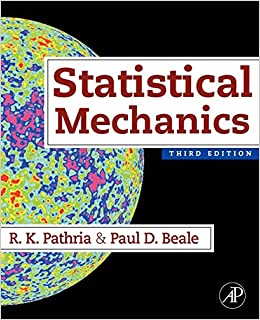(a) Setting (bar{N}_{++}+bar{N}_{--}+bar{N}_{+-}=frac{1}{2} q N), we find that, in equilibrium, (gamma=1 /left(1+s bar{L}^{2} ight)). So, in general,...
Question:
(a) Setting \(\bar{N}_{++}+\bar{N}_{--}+\bar{N}_{+-}=\frac{1}{2} q N\), we find that, in equilibrium, \(\gamma=1 /\left(1+s \bar{L}^{2}\right)\). So, in general, it may be written as \(1 /\left(1+s L^{2}\right)\).
(b) As in Problem 12.4, we write \(Q(B, T)=\sum_{L} \exp f(L)\), where
\[
\begin{aligned}
& f(L)=\ln N !-\ln N_{+} !-\ln N_{-} !-\beta E, \text { with } \\
& N_{+}=\frac{1}{2} N(1+L), N_{-}=\frac{1}{2} N(1-L), \\
& \text { and } E=-J\left(N_{++}+N_{--}-N_{+-}\right)-\mu B\left(N_{+}-N_{-}\right) \\
&=-J \cdot \frac{1}{2} q N\left(L^{2}+s\right) /\left(1+s L^{2}\right)-\mu B N L .
\end{aligned}
\]
The condition that maximizes \(f(L)\) now reads:
\[
\frac{1}{2} \ln \frac{1+L}{1-L}=\beta\left[q J \frac{\left(1-s^{2}\right) L}{\left(1+s L^{2}\right)^{2}}+\mu B\right]
\]
In the close vicinity of the critical point, \(L \ll 1-\) with the result that
\[
\frac{1}{2} \ln \frac{1+L}{1-L} \simeq \beta\left[q J\left(1-s^{2}\right) L+\mu B\right] \quad\left(T \simeq T_{c}\right) .
\]
Comparing this with the corresponding equation in the solution to Problem 12.4, we infer that the critical behavior of this model is qualitatively the same as one encounters in the Bragg-Williams approximation. Quantitatively, though, the effective spin-spin interaction is reduced by the factor \(\left(1-s^{2}\right)\) - leading to a critical temperature \(T_{c}=\left(1-s^{2}\right) q J / k\), instead of \(q J / k\).
(c) As for the specific-heat singularity, the limit \(T \rightarrow T_{c-}\) would be identical with the one obtained in Sec. 12.5; see the derivation leading to eqn. (12.5.18) and note that the replacement of \(J\) by \(\left(1-s^{2}\right) J\) does not affect the final result \(\frac{3}{2} N k\). For \(T>T_{c}, \bar{L}_{0}\) is identically zero. We are then left with a finite configurational energy, \(-\frac{1}{2} q J N s\), that arises from the (assumed) short-range order in the system; however, unlike in the Bethe approximation, this energy is temperature-independent and hence does not entail any specific heat. The singularity in question is, therefore, precisely the same as the one encountered in Sec. 12.5 and depicted in Fig. 12.8.
Step by Step Answer:






